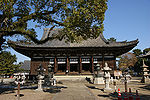
Setchūyō
Encyclopedia

Muromachi period
The is a division of Japanese history running from approximately 1336 to 1573. The period marks the governance of the Muromachi or Ashikaga shogunate, which was officially established in 1338 by the first Muromachi shogun, Ashikaga Takauji, two years after the brief Kemmu restoration of imperial...
from the fusion of elements from three different antecedent styles, namely the wayō
Wayō
is the name given to a style developed in art and architecture in Japan during the Heian period, mainly by the esoteric sects Tendai and Shingon. Together with Zenshūyō and Daibutsuyō, it is one of the three most significant styles developed by Japanese Buddhism on the basis of Chinese models.The...
, the daibutsuyō
Daibutsuyō
is a Japanese religious architectural style which emerged in the late 12th or early 13th century. Together with Wayō and Zenshūyō, it is one of the three most significant styles developed by Japanese Buddhism on the basis of Chinese models....
and zen'yō
Zen'yō
-Features: is a Japanese Buddhist architectural style derived from Chinese Song Dynasty architecture. Named after the Zen sect of Buddhism which brought it to Japan, it emerged in the late 12th or early 13th century. Together with Wayō and Daibutsuyō, it is one of the three most significant styles...
. It is exemplified by the main hall
Main Hall (Japanese Buddhism)
Main hall is the term used in English for the building within a Japanese Buddhist temple compound which enshrines the main object of veneration. Because the various denominations deliberately use different terms, this single English term translates several Japanese words, among them Butsuden,...
at Kakurin-ji. The combination of wayō and daibutsuyō in particular became so frequent that sometimes it is classed separately by scholars under the name .
See also
- Japanese Buddhist architecture - Heian period
- DaibutsuyōDaibutsuyōis a Japanese religious architectural style which emerged in the late 12th or early 13th century. Together with Wayō and Zenshūyō, it is one of the three most significant styles developed by Japanese Buddhism on the basis of Chinese models....
- WayōWayōis the name given to a style developed in art and architecture in Japan during the Heian period, mainly by the esoteric sects Tendai and Shingon. Together with Zenshūyō and Daibutsuyō, it is one of the three most significant styles developed by Japanese Buddhism on the basis of Chinese models.The...
- Zenshūyō

